My son used to ride bulls. I remember those rodeo days vividly.

I can still smell the dust, hay and leather. I can hear the crowds, the bells, the Garth Brooks music, the rows of bulls huffing and clamoring their hoofs. As my son climbed into the bucking chute and lowered himself onto the bull, you could see his veins bulge and his knuckles turn white. He was knocked around the chute as he awaited the fight for 8 seconds to begin.
Weekend after weekend, our whole family was filled with pure adrenaline from the sidelines. We would sweat and pace side to side, waiting for the horn to sound. The sad part was, my daughter, his little sister, never saw him actually ride the bull. She has epilepsy and this immense tension always caused her to have a seizure right before her brother burst out of the chute and into the arena. In those moments, holding one seizing child while you watched another fight to stay on a furious bull, 8 seconds felt like an eternity.
Today, communication research tells us what else can happen in a matter of 7 to 9 seconds. We have learned that we have about 8 whole seconds to make a first impression. That initial greeting is so critical because our conditioned reptilian brain makes a subconscious decision within those seconds. Fight or flight, you might be thinking? It’s actually a bit more complex than that. You see, the human brain used to be wired for survival – where fight or flight originated. But the complex brain of today has been conditioned to still make these involuntary determinations based on the very first interaction with someone new.

Although we aren’t constantly facing imminent threats to our survival, we still have fear. We fear boredom, extreme complexity and change of any kind. All of these fears or deterrents can cause our audience to shut down, look down and yes, pick up a smart phone, for a safer or a more stimulating and manageable interaction. This is why, in any presentation, the opening is absolutely critical. Before we even open our mouth, each audience member’s basal ganglia (a structure of the brain) is sizing us up and making sweeping assumptions based on posture, expression, energy, build and attire.
And then we open our mouth. Our words, our tone, our presence and cadence are critical to engaging an audience early on. In those first 8 seconds, we must delight or surprise. Introduce yourself and your intention after an unpredictable opening and your audience will be more likely to participate in the journey you have planned for them. If you open with “hi my name is…..I represent…. And I’m here to talk to you about ……”, you will have effectively convinced your audience that they will be bored or underwhelmed by your message – leading them to check out before you have a chance to get to the “good part.”
Novelty on the other hand, produces dopamine, and that is the chemical of focus. If you can make them laugh, you just gave the precious gift of endorphins, and you are on your way to building a connection with your audience. When you open with an engaging question, an informal, perplexing statement or something that is spectacular, your listeners will lean in with intrigue, careful not to miss the rewards you have in store for them.
8 seconds holds a lot of power. Keeping them roped in beyond that is both an art and a sport.
Want to learn more on capturing and holding the attention of an audience? Click here for a free download of Part 1 of my ebook Talk To The Brain.
P.s. Are you an audio book lover? I’ve got something for you in the works….


Recent Comments